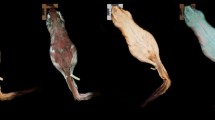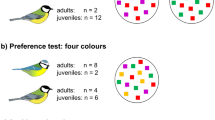Summary
The noctural desert elapid Walterinnesia aegyptia Lataste was observed in the habitat and in captivity. This species is of extremely poor sight and finds its prey mainly by its olfactory sense. It is active around midnight at temperatures down to 10°C and collects various kinds of diurnal and crepuscular reptiles, which are pulled out of their hidingplaces. Its extremely semantic coloration serves as a defense device and does not come in to conflict with its specialized way of foraging.
Similar content being viewed by others
References
Barash, A., Hoofien, J. H.: Reptiles of Israel [Hebrew]. Hakibbutz: Hameuchad, Ltd. 1966.
Gitter, S., Kochwa, S., De Vries, A., Levi, G., Rechnic, Jr., Caspar, J.: Studies on snake venoms of the Near East. Amer. J. trop. Med. Hyg. 11, 861–868 (1962).
Haas, G.: On the present state of our knowledge of the Herpetofauna of Palestine. Bull. Res. Council Israel 1, 65–95 (1951).
Marx, H.: The elapid genus of snakes Walterinnesia. Fieldiana Zool. 34 (16), 189–196 (1953).
Medelssohn, H.: On the biology of the venomous snakes of Israel, Part I. Israel J. Zool. 12 (1–4), 143–170 (1963).
Theodor, O.: On poisonous snakes and snake bite in Israel. Jerusalem: The Israel Sci. Press 1955.
Author information
Authors and Affiliations
Additional information
I dedicate this publication to Josef Orr, Biology teacher in Mashabbei Sadde, who, years ago, guided my first herpetological steps in the Negev Desert, and with his friendship and help laid the basis for this and other ecological and ethological investigations.
Rights and permissions
About this article
Cite this article
Zinner, H. On ecology and the significance of semantic coloration in the nocturnal desert-elapid Walterinnesia aegyptia Lataste (Reptiles, Ophidia). Oecologia 7, 267–275 (1971). https://doi.org/10.1007/BF00345217
Received:
Issue Date:
DOI: https://doi.org/10.1007/BF00345217




